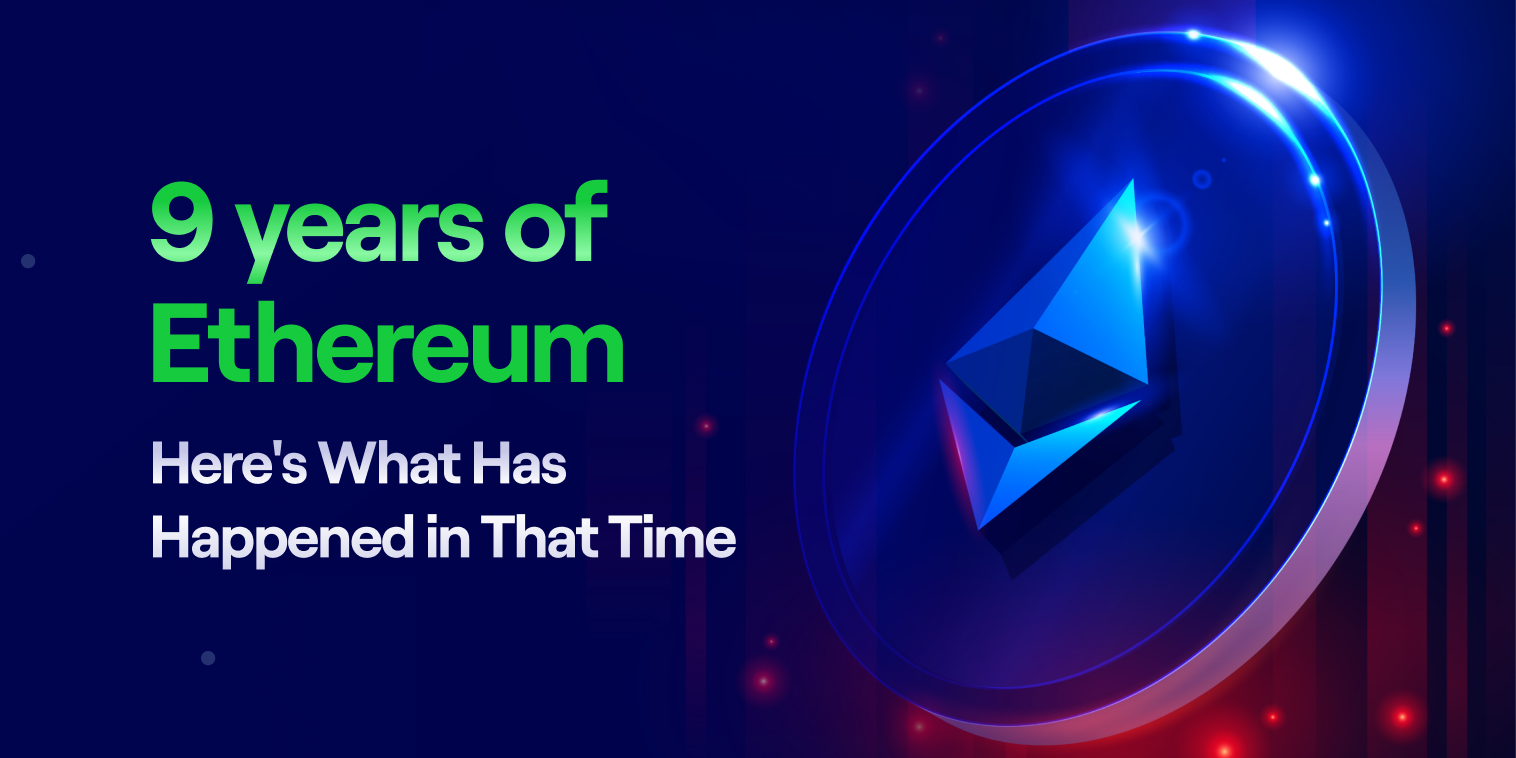
9 Years of Ethereum: Here's What Has Happened in That Time
Cast your mind back to the early days of crypto. Bitcoin was the new kid on the block, grabbing headlines and turning heads. But behind the scenes, a young programmer named Vitalik Buterin had a vision for something even bigger – a platform that could do more than just digital money. That vision became Ethereum, and today, we're celebrating its 9th birthday!
So, what exactly is Ethereum? In a nutshell, it's like a giant digital playground where developers can build all sorts of cool stuff, from decentralized apps (DApps) to innovative financial tools. But Ethereum isn't just about fun and games; it's the second-largest cryptocurrency in the world, and its technology is changing how we think about money, ownership, and even the internet itself.
In this blog post, we'll travel down memory lane to explore Ethereum's remarkable journey from a groundbreaking idea to a global powerhouse.
The Early Days: Ethereum's Birth and First Steps (2015)
Back in 2015, Vitalik Buterin, a young programmer with a passion for blockchain technology, introduced the world to Ethereum. Buterin envisioned a platform that went beyond Bitcoin's simple peer-to-peer transactions. He wanted to create a decentralized platform where developers could build and deploy their own applications, powered by a revolutionary concept called smart contracts.
Smart contracts are like self-executing agreements with the terms of the deal directly written into code. They automatically enforce the rules of an agreement, eliminating the need for intermediaries like lawyers or banks. This opened up a world of possibilities, from creating decentralized financial systems to building entirely new digital economies.
Ethereum's launch was met with immense excitement and anticipation. The project raised a staggering $18.3 million in its initial crowdfunding campaign, making it one of the most successful crowdfunding projects at the time. This early success laid the groundwork for Ethereum's future growth and development.
However, like any new technology, Ethereum faced its fair share of challenges in its early days. Security vulnerabilities, scaling issues, and regulatory uncertainties were just a few of the hurdles that the Ethereum community had to overcome. But despite these growing pains, the potential of Ethereum was undeniable, and its passionate community continued to build and innovate, paving the way for the remarkable achievements that were to come.
Read more: Why Ethereum Offers Strong Potential for Crypto Traders in 2024
Growing Pains and Promising Innovations (2016-2017)
Ethereum's early success wasn't without its hiccups. In 2016, a major setback hit the community: the DAO hack. The DAO, a decentralized autonomous organization built on Ethereum, was designed to act like a venture capital fund for the platform. However, a vulnerability in its code led to a massive theft of $60 million worth of Ether. Ouch!
This event shook the Ethereum community to its core, raising questions about the platform's security and future. But, in a display of resilience and determination, the Ethereum community rallied together. They made the tough decision to implement a "hard fork," essentially splitting the Ethereum blockchain into two. This controversial move aimed to reverse the hack and restore the stolen funds. While it sparked debate, it ultimately demonstrated the community's commitment to Ethereum's success and its ability to adapt to challenges.
From the ashes of the DAO hack arose a wave of promising innovations. ERC-20 tokens, a standard for creating and managing custom tokens on Ethereum, emerged and fueled the ICO boom of 2017. Think of these tokens as digital coupons that can represent anything from a share in a new project to a piece of digital art. This led to an explosion of new projects and investment opportunities, putting Ethereum on the map as a hub for innovation.
Decentralized applications (DApps) also started to gain traction on Ethereum. These DApps are essentially software programs that run on a decentralized network, offering everything from games and social networks to prediction markets and decentralized exchanges. This growing ecosystem showcased the versatility and potential of Ethereum's platform, attracting a wider audience of users and developers.
However, as Ethereum's popularity grew, so did the challenges. The network struggled to handle the increased demand, leading to slow transaction times and high fees. This highlighted the urgent need for scaling solutions to ensure Ethereum could continue to grow and evolve.
The Rise of DeFi and NFTs (2018-2020)
While Ethereum faced its fair share of growing pains, it also laid the groundwork for a wave of groundbreaking innovations. One of the most significant developments was the rise of decentralized finance (DeFi). Think of DeFi as financial services without the middlemen – no banks, no brokers, just code and smart contracts.
Ethereum became the hotbed for DeFi projects, with lending platforms, decentralized exchanges, and other innovative financial tools popping up left and right. This newfound accessibility to financial services without traditional gatekeepers democratized finance and empowered individuals to take control of their own assets.
Alongside DeFi, another phenomenon captured the world's attention: non-fungible tokens (NFTs). These unique digital assets took the art and collectibles world by storm. Suddenly, anyone could own and trade digital art, music, and other forms of digital expression, creating new opportunities for creators and collectors alike.
But as Ethereum's ecosystem flourished, it also faced growing concerns about its environmental impact. The network's energy consumption, primarily due to its proof-of-work consensus mechanism, came under scrutiny. This sparked a renewed focus on finding more sustainable solutions for Ethereum's future.
Despite the challenges, the Ethereum community remained committed to improving the platform. Ongoing efforts to enhance scalability, reduce fees, and transition to a more energy-efficient consensus mechanism were underway, setting the stage for Ethereum's next evolutionary leap.
You might also like: Is Ethereum A Good Investment
The Merge and Beyond: Ethereum's Evolution (2021-2023)
Fast forward to 2021, and the Ethereum community embarked on its most ambitious upgrade yet: The Merge. This wasn't just a minor tweak; it was a complete overhaul of how Ethereum operates. Think of it like switching from a gas-guzzling car to an electric one. The Merge transitioned Ethereum from a proof-of-work (PoW) consensus mechanism, similar to Bitcoin's energy-intensive mining process, to a proof-of-stake (PoS) system.
But what does this all mean for you? Well, PoS is a game-changer for Ethereum. It drastically reduces energy consumption, making the network more environmentally friendly. It also enhances security and opens the door for faster transactions and lower fees. In short, The Merge was a major step towards making Ethereum more scalable, sustainable, and accessible for everyone.
Of course, such a massive change didn't come without its share of challenges and criticisms. Some worried about potential security risks or the increased centralization of the network due to the staking process. But despite the initial skepticism, The Merge was successfully implemented in 2022, marking a major milestone in Ethereum's evolution.
But the journey doesn't stop there. The Ethereum community continues to push the boundaries of what's possible. Ongoing developments like sharding, a technique to split the network into smaller pieces for faster processing, and layer 2 solutions, which create a separate layer on top of Ethereum to handle transactions more efficiently, are paving the way for a more scalable and user-friendly future.
Ethereum Today: What's Next?
Nine years on, Ethereum has come a long way from its humble beginnings. It has weathered storms, embraced innovation, and emerged as a driving force in the blockchain space. From its early days as a platform for building decentralized applications to the rise of DeFi and NFTs, Ethereum has consistently pushed the boundaries of what's possible.
Today, Ethereum's ecosystem is thriving, with a vibrant community of developers, users, and businesses. Its market position as the second-largest cryptocurrency by market capitalization is a testament to its resilience and continued innovation. Leading DApps like Uniswap, Aave, and OpenSea have revolutionized industries and empowered individuals in ways we couldn't have imagined just a few years ago.
As we look to the future, the possibilities for Ethereum are endless. The ongoing development of scalability solutions, the integration of privacy features, and the exploration of new use cases like decentralized identity and governance are just a few of the exciting prospects on the horizon. Of course, challenges like regulatory uncertainties and the need for further decentralization remain. But with a passionate and dedicated community behind it, Ethereum is well-positioned to tackle these challenges head-on and continue shaping the future of blockchain technology and the decentralized web.
Ethereum's journey is a testament to the power of innovation, collaboration, and the unwavering belief in a decentralized future. As we celebrate its 9th anniversary, it's clear that Ethereum's impact on the world is just beginning.
Conclusion on 9 Years of Ethereum
Nine years in, and Ethereum's journey has been nothing short of extraordinary. From humble beginnings to a global powerhouse, it's reshaped the world of finance, art, and technology. We've witnessed the highs of innovation and the lows of challenges, but through it all, one thing remains clear: Ethereum is a force to be reckoned with.
So, what are your thoughts on Ethereum's incredible journey? Share your experiences, predictions, and hopes for the future in the comments below. Let's celebrate together and continue to build a decentralized future where innovation and opportunity thrive.
Want to stay ahead of the curve and get the latest updates on Ethereum and other cryptocurrencies? Join our community and be part of the conversation shaping the future of finance.
Read More:



